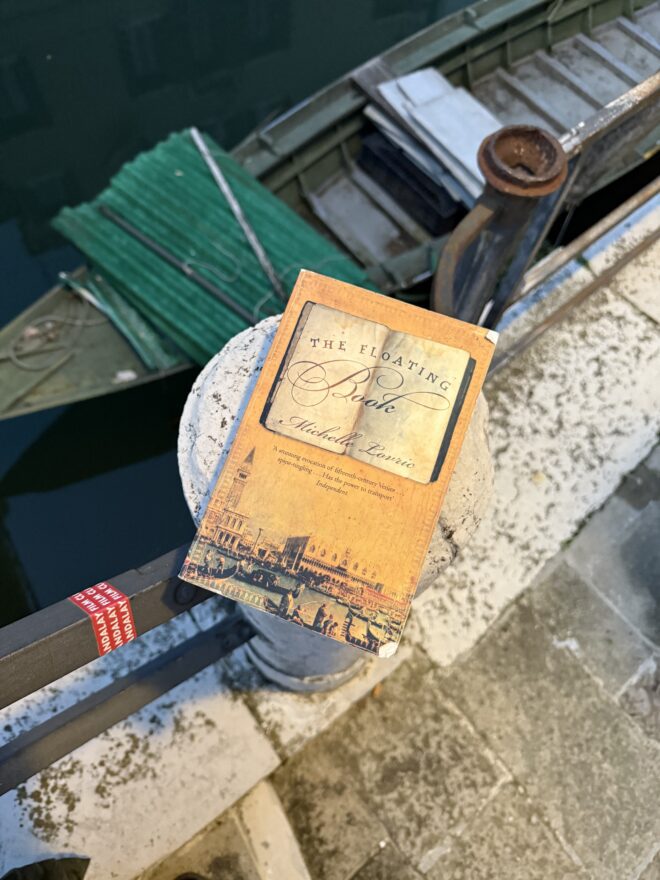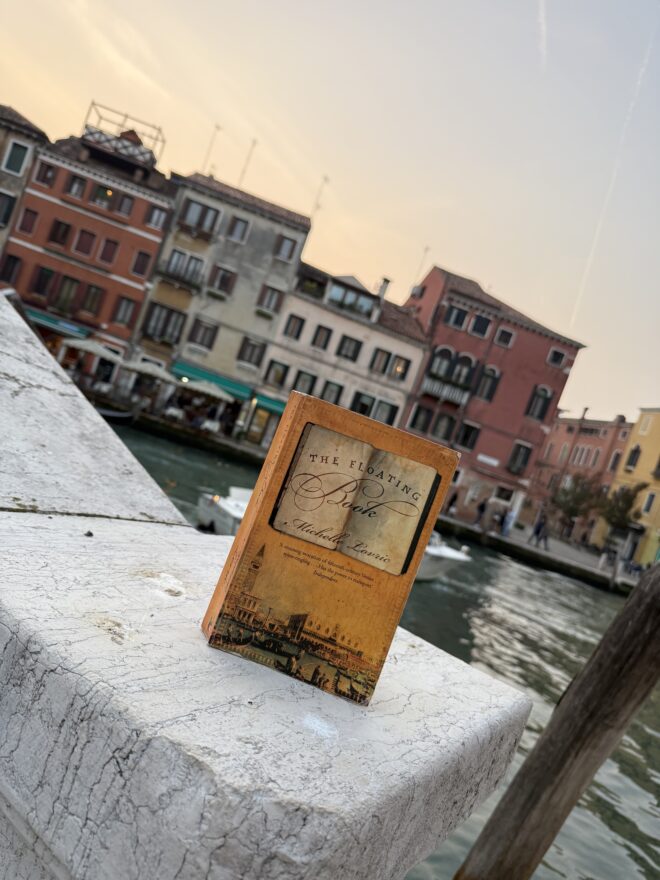Literary fiction set in the ENGLISH FENLANDS
Novel set in mid-15th Century VENICE
26th November 2025
 The Floating Book by Michelle Lovric, novel set in mid-15th Century VENICE.
The Floating Book by Michelle Lovric, novel set in mid-15th Century VENICE.
#fromourbookshelves
This novel has been on my bookshelves for many a year and as I was heading for Venice and #VeniceNoir, it seemed like the perfect choice. It has been out of print for a while but now it seems to be available once again.
Sosia is a young Dalmation woman has found her way to La Serenissima with members of her family. Shehas endured terrible torture on the journey. It is surmised that her traumatic experiences have moulded her into the woman she now is; and that woman is a compulsive seeker of pleasures, of carnal connection, and her husband is at his wit’s end to know how to manage their union. We are told that even her name has a ‘sinister’ meaning in Italian (something along the lines of a double or Doppelgänger in today’s parlance, but what it meant back then is not really made clear).
Sosia seems to suffer from hyperosmia, in that she can detect a variety of smells on people, what they have eaten or whether they have recently had a sexual encounter, and this gives her a strange aura, causing people to swerve her in the street. Even the courtesans keep a wary eye on her. She is married but her husband is at pains to escape her presence. Thus, early on, the reader senses that she is different and may well come to play an interesting part in an unusual storyline.
We then meet young Bruno Uguccione, who teams up with the scribe Felice Feliciano. 15th Century Venice is the vibrant place for a young man, and he takes up a position in the von Speyer (da Spira in Italian) printing works. This is all told over a couple of pages – it feels the author quickly had to set the scene in order to proceed with her story. And that devices is entrenched in the narrative and proves to be a little problematical, on repeat, as the story unfolds. A further device is letter writing, which serves to fill out the storyline.
place for a young man, and he takes up a position in the von Speyer (da Spira in Italian) printing works. This is all told over a couple of pages – it feels the author quickly had to set the scene in order to proceed with her story. And that devices is entrenched in the narrative and proves to be a little problematical, on repeat, as the story unfolds. A further device is letter writing, which serves to fill out the storyline.
Sosia’s story is one coloured by sexual liaisons, and when the novel was first published in the early 21st Century, it perhaps seemed racy. Now it feels just a little tawdry and tedious. I had hoped for a story that was on a par with Sarah Dunant’s “In The Company of the Courtesan“, also set in Venice just a few decades later, but the lightness of touch and the character development in that novel are lacking in this novel.
There is also mention of an evolving story set in Rome in the 1st Century BCE and this feels a little discombobulating and random – until there is understanding for its inclusion.
Venice of the 15th Century comes through loud and clear in this novel, it is beautifully evoked in the skilled hands of this author. The grime, the mists, the people and the smells, sights and sounds all meld and become a powerful character that informs the story. It is rare to find such a rich evocation that is so transportive and lyrical in one. And yet. It is clear the author has done a huge amount of research and has fed her findings into the narrative with enormous enthusiasm, which can make the novel feel quite unwieldy at times. We learn all kinds of things about the printing trade, Bellini, contraception and more, and on one level it is interesting but on another it feels just too overwhelming. The overkill of information really needed the attention of an editor.
I had such high hopes for this novel, given I had kept it to take on a trip to Venice, but felt a little dated both in content and format (tiny printing coming in at nearly 500 pages), so it sadly felt a little disappointing.
Tina for the TripFiction Team
Join team TripFiction on Social Media:
Twitter (@TripFiction), Facebook (@TripFiction.Literarywanderlust), YouTube (TripFiction #Literarywanderlust), Instagram (@TripFiction) and Pinterest (@TripFiction) and BlueSky(tripfiction.bsky.social) and Threads (@tripfiction)

 Please wait...
Please wait...
